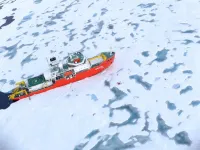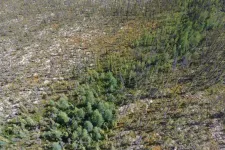Icebreaker's cyclone encounter reveals faster sea ice decline
2021-04-29
(Press-News.org) In August 2016 a massive storm on par with a Category 2 hurricane churned in the Arctic Ocean. The cyclone led to the third-lowest sea ice extent ever recorded. But what made the Great Arctic Cyclone of 2016 particularly appealing to scientists was the proximity of the Korean icebreaker Araon.
For the first time ever, scientists were able to see exactly what happens to the ocean and sea ice when a cyclone hits. University of Alaska Fairbanks researchers and their international colleagues recently published a new study showing that sea ice declined 5.7 times faster than normal during the storm. They were also able to prove that the rapid decline was driven by cyclone-triggered processes within the ocean.
"Generally, when storms come in, they decrease sea ice, but scientists didn't understand what really caused it," said lead author Xiangdong Zhang from the UAF International Arctic Research Center.
There was general speculation that sea ice declined solely from atmospheric processes melting ice from above. Zhang and his team proved this theory incomplete using "in-situ" observations from directly inside the cyclone. The measurements reflected things like air and ocean temperature, radiation, wind and ocean currents.
It was a stroke of good luck for science, and perhaps a bit nerve-racking for those onboard, that the icebreaker was in position to capture data from the cyclone. Usually ships try to avoid such storms, but Araon had just sailed into the middle of an ice-covered zone and was locked in an ice floe.
Thanks to the ship's position so close to the storm, Xiangdong and his team were able to explain that cyclone-related sea ice loss is primarily due to two physical ocean processes.
First, strong spinning winds force the surface water to move away from the cyclone. This draws deeper warm water to the surface. Despite this warm water upwelling, a small layer of cool water remains directly beneath the sea ice.
That's where a second process comes into play. The strong cyclone winds act like a blender, mixing the surface water.
Together, the warm water upwelling and the surface turbulence warm the entire upper ocean water column and melt the sea ice from below.
Although the August storm raged for only 10 days, there were lasting effects.
"It's not just the storm itself," explained Zhang. "It has lingering effects because of the enhanced ice-albedo feedback."
The enlarged patches of open water from the storm absorb more heat, which melts more sea ice, causing even more open water. From Aug. 13-22, the amount of sea ice in the entire Arctic Ocean declined by 230,000 square miles, an area more than twice the size of the state of Arizona.
Xiangdong is now working with a new computer model for the Department of Energy to evaluate whether climate change will lead to more Arctic cyclones. Previous research shows that over the past half-century, the number and intensity of cyclones in the Arctic have increased. Some of those storms, like the biggest Arctic cyclone on record in 2012, also led to record low sea ice extent.
INFORMATION:
Additional co-authors for this paper include two University of Alaska Fairbanks graduate students, Liran Peng and Han Tang, along with Korean researchers Joo-Hong Kim, Kyoung-Ho Cho and Baek-Min Kim, and Zhaomin Wang from China.
[Attachments] See images for this press release:

ELSE PRESS RELEASES FROM THIS DATE:
2021-04-29
Older adults were significantly affected by isolation and stress during Oregon's initial COVID-19 lockdown last spring, but they were also able to find connection and meaning in community, new hobbies and time for themselves, a recent Oregon State University study found.
If resilience is understood as the ability to see positives in the midst of a negative situation, then many of the study's participants demonstrated resilience during that time, the researchers said.
"A lot of times we think about resilience as a personality trait, and it's true that there are some qualities that may help people experience that. But in the end, resilience is something that is shared," said Heidi Igarashi, ...
2021-04-29
DALLAS, April 29, 2021 – Last Friday, the Centers for Disease Control and Prevention (CDC) and the U.S. Food & Drug Administration (FDA) lifted the pause in administration of the Johnson & Johnson (Janssen) COVID-19 vaccine in the U.S. The temporary pause was due to reports of a serious condition called cerebral venous sinus thrombosis (CVST), which refers to blood clots in the brain’s veins - not in the arteries, as is the case for most strokes - in combination with thrombocytopenia (low blood platelet count). CVST and thrombocytopenia together is called thrombosis-thrombocytopenia syndrome (TTS). When TTS is linked to receiving a COVID-19 vaccine, it is called vaccine-induced immune thrombotic thrombocytopenia ...
2021-04-29
Tomorrow's cutting-edge technology will need electronics that can tolerate extreme conditions. That's why a group of researchers led by Michigan State University's Jason Nicholas is building stronger circuits today.
Nicholas and his team have developed more heat resilient silver circuitry with an assist from nickel. The team described the work, which was funded by the U.S. Department of Energy Solid Oxide Fuel Cell Program, on April 15 in the journal Scripta Materialia.
The types of devices that the MSU team is working to benefit -- next-generation fuel cells, high-temperature semiconductors and solid oxide electrolysis cells -- could have ...
2021-04-29
New research indicates that the computer-based models currently used to simulate how Earth's climate will change in the future underestimate the impact that forest fires and drying climate are having on the world's northernmost forests, which make up the largest forest biome on the planet. It's an important understanding because these northern forests absorb a significant amount of Earth's carbon dioxide.
The finding, reached by studying 30 years of the world's forests using NASA satellite imaging data, suggests that forests won't be able to sequester as much carbon ...
2021-04-29
In a novel effort to combat COVID-19 misinformation, a group of women researchers, including nurse scientists from the University of Pennsylvania School of Nursing (Penn Nursing), launched the Dear Pandemic social media campaign in March 2020. It delivers curated, comprehensive, and timely information about the COVID-19 pandemic in a question-and-answer format. Complex topics such as COVID-19 aerosol transmission, risk reduction strategies to avoid infection, and excess mortality are explained in common language and shared widely.
Now with more than 100,000 followers and accounts on Facebook, ...
2021-04-29
FINDINGS
A UCLA-led study shows that physicians frequently order preventive medical services for adult Medicare beneficiaries that are considered unnecessary and of "low value" by the U.S. Preventive Services Task Force -- at a cost of $478 million per year.
The researchers analyzed national survey data over a 10-year period, looking specifically at seven preventive services given a "D" rating by the task force, and discovered that these services were ordered more than 31 million times annually.
BACKGROUND
The U.S. Preventive Services Task Force, an independent panel appointed by the Department of Health and Human Services, makes recommendations on the value of clinical preventive ...
2021-04-29
The field of soft robotics has exploded in the past decade, as ever more researchers seek to make real the potential of these pliant, flexible automata in a variety of realms, including search and rescue, exploration and medicine.
For all the excitement surrounding these new machines, however, UC Santa Barbara mechanical engineering professor Elliot Hawkes wants to ensure that soft robotics research is more than just a flash in the pan. "Some new, rapidly growing fields never take root, while others become thriving disciplines," Hawkes said.
To help guarantee the longevity of soft robotics ...
2021-04-29
New York, NY--Research-practice partnerships (RPPs), long-term collaborations between researchers, policy makers and practitioners, represent an especially promising strategy for making sure that all children benefit from early childhood education, according to END ...
2021-04-29
People living with a child who attends school in-person have an increased risk of reporting evidence of COVID-19, but teacher masking, symptom screening, and other mitigation measures in schools may be able to minimize that excess risk, suggests a study led by researchers at the Johns Hopkins Bloomberg School of Public Health.
For their study, the researchers analyzed nearly 600,000 responses from an ongoing Facebook-based COVID-19 symptom survey in the United States over two periods between November 2020 and February 2021 before vaccines were widely available in the U.S. The researchers found that those living with a child engaged in full-time, ...
2021-04-29
April 29, 2021 -An increasing number of digital mental health interventions are designed for adolescents and young people with a range of mental health issues, but the evidence on their effectiveness is mixed, according to research by Columbia University Mailman School of Public Health and Spark Street Advisors.
Computerized cognitive behavioral therapy was found effective for anxiety and depression in adolescents and young people holding promise for increasing access to mental health treatment for these conditions. However, the effectiveness of other digital interventions, including therapeutic video games, mobile apps, or social networking sites, and addressing a range of other mental health outcomes remain ...
LAST 30 PRESS RELEASES:
[Press-News.org] Icebreaker's cyclone encounter reveals faster sea ice decline

